Medical Alert Review
An uncomplicated, affordable medical alert system with quick response time
SafeHome.org may receive compensation from some providers listed on this page. Learn More
We may receive compensation from some providers listed on this page. Learn More
An uncomplicated, affordable medical alert system with quick response time
You might be surprised to learn that Connect America, Medical Alert’s parent company, has been making medical alert systems for over a decade.1 Their tagline says it all: “Connecting is Caring.”
Not only has Medical Alert figured out some pretty good solutions for helping older adults and caregivers connect with each other and first responders, they have figured out how to do it in lickety-split time.
We always say that in the world of medical alert systems, response time is everything, and we think you’ll be pleased when you see how quickly Medical Alert’s highly trained monitoring center associates connect during an emergency (or in our case, a test run). But with that said, Medical Alert isn’t a perfect system… we came across a couple of minor issues that you should know about.
A Must Read: No system is perfect. But we have found quite a few that we would recommend to our family members. For an overview of some of the best, read our comprehensive Best Medical Alert Systems of 2024.
We’ll share everything we discovered in our comprehensive review. Overall, we found plenty to like about its wearability, features and the complementary app that supports caregivers. And a follow-up review confirmed that Medical Alert continues to offer this same strong system at the same price. In other words, while inflation may be impacting your budget elsewhere, Medical Alert has held steady on their prices.
Now, let’s dive into the details.
Check out more recommendations from the SafeHome team:
Sitting at our kitchen table, we unwrapped our newly arrived On the Go + Button medical alert system from Medical Alert. It didn’t take long. Unlike top-rated alert systems like Medical Guardian, Medical Alert comes with few bells and whistles — it sticks to the basics, which can be a very good thing.
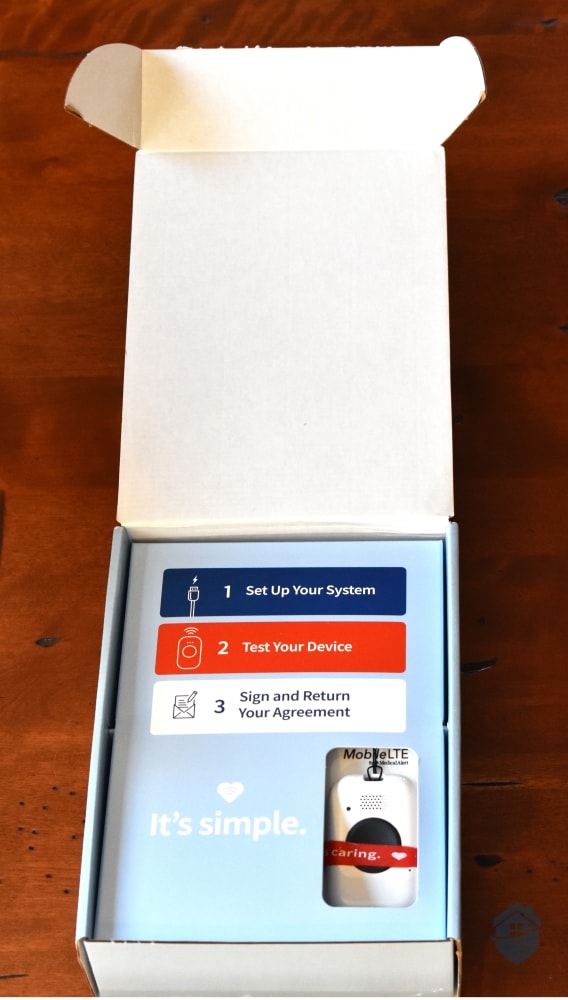
Unboxing Medical Alert
We laid out the pieces on our table. First, the mobile device, a Mobile LTE, with lanyard attached. Next, the belt clip, which can also be used with the mobile device. Then, the charger for the mobile device. Finally, the at-home pieces, a help button on a watch band with an optional lanyard. Aside from the SetUp Guide, we had everything we needed.
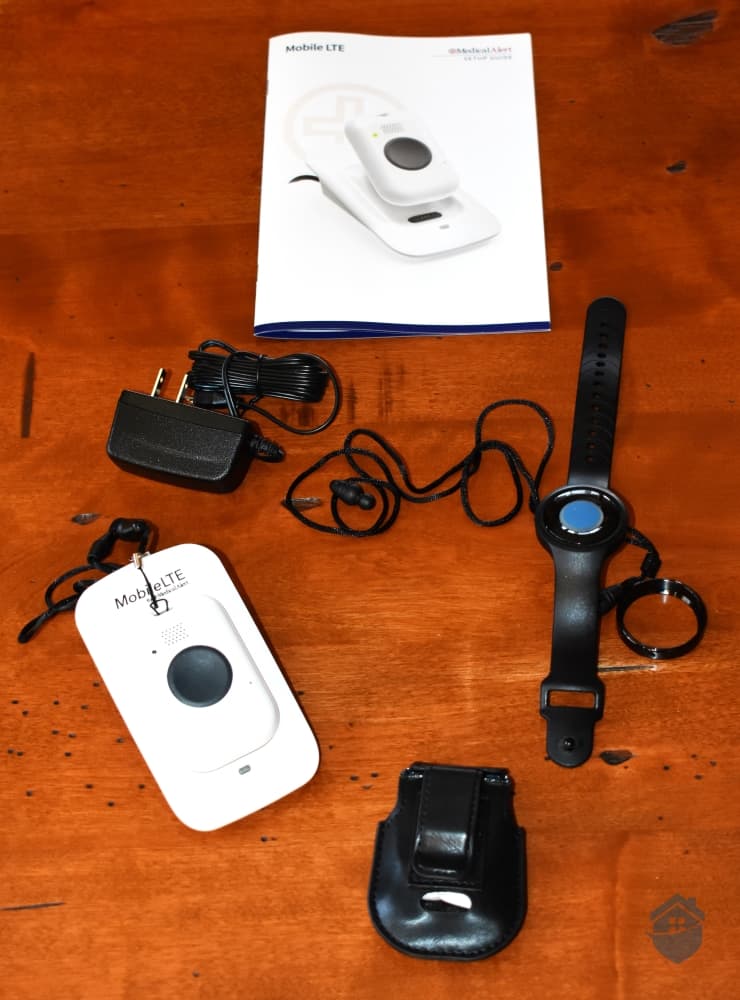
Medical Alert Equipment
From the looks of it, we had an efficient system in front of us. We could immediately see that the system centered around the Mobile LTE, which serves as both a mobile unit and an at-home base unit. And our first impression of this mobile device was a good one. It was small, white, and discreet. In fact, our measurements came to 2 ¾ inches in length, 1 ¾ inches in width, and ⅝ inch in depth — or about the size of a small box of raisins.
One thing that we noted — this mobile device did not seem to be an all-in-one device, or a medical alert that builds everything, including fall detection, into a single device. Upon further investigation, we found that Medical Alert does, indeed, offer this alternative, but more on that later.
The user manual highlights three steps for setting up the system.
It can’t really be that easy to set up, right? Well, you’d be surprised. First, we plugged in the charging cradle to a wall outlet near our counter. Next, we placed our mobile device in the charging cradle.
The more detailed setup guide told us to wait until the device is fully charged, signaled by an automated voice. We were fully expecting to wait several hours since that’s how it usually goes with these mobile alert devices. We had to charge the Mobile 2.0 from our Medical Guardian review for three hours during the initial setup, for instance. However, shortly after we started charging the Medical Alert device, we heard the automated voice we were waiting for. And we were up and running in under 5 minutes.
Next comes the testing part. We were instructed to hold the Help button on the device for one second, and after doing so, a monitoring center associate soon responded to our test call and confirmed that our system was operating correctly.
And with that, our quick setup was complete. We just had to sign a bit of paperwork, send it back to Medical Alert, and that’s it.
Recommendation: Some companies may be hesitant to tie up their monitoring center with user tests. However, Medical Alert encourages you to test your system monthly.
When charging your medical device, the LED light on the charger will turn red, indicating that the battery is charging. When charging is complete, the light will turn green, and a voice will also announce the charging status. We found that charging takes between two and three hours, typical for most mobile medical alert devices.
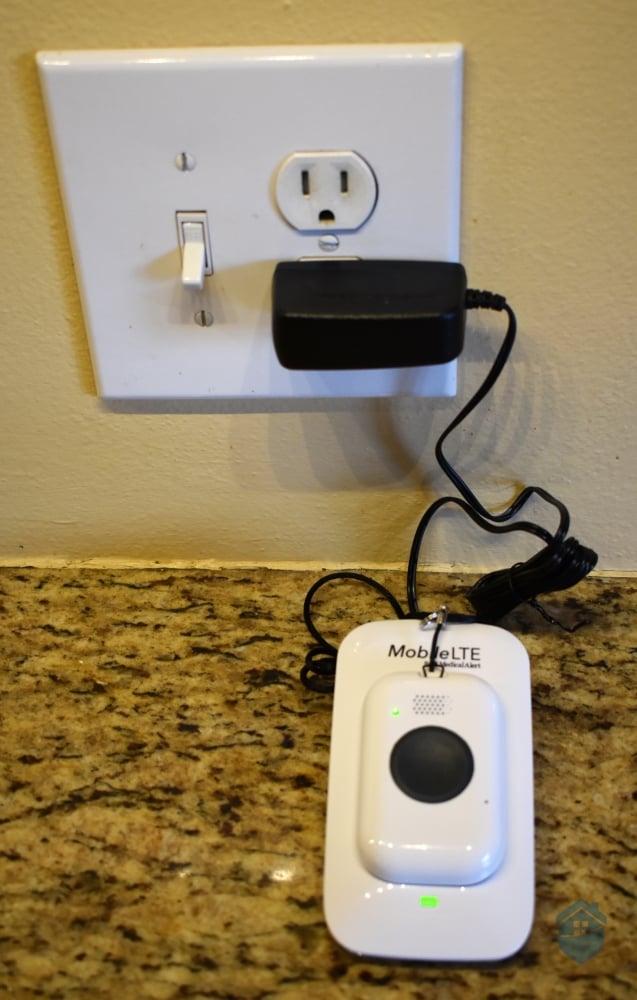
Charging Medical Alert
While many on-the-go medical devices have a 24-hour battery life, Medical Alert’s mobile system offers a five-day battery life. Not bad! It fares even better in real-life testing; we found that it could last up to a week on a single charge. Of course, we recommend charging it on the regular instead of waiting for the battery to drain. That way, you’re sure it’s on and ready to go whenever you might need it to.
Pro Tip: When the LED button on the Mobile LTE is blinking green, it indicates that the device has an adequate charge and is looking for a cellular connection.
In many ways the design of medical alert mobile devices is a balancing act. On the one hand, companies strive to offer beneficial safety features: two-way talk, location detection, fall detection. On the other hand, they try to design devices that are lightweight, comfortable to wear and discreet. The mobile devices that offer the most features can be the most cumbersome to wear. And those that are least obtrusive may be missing a key feature or two.
We were pleased to learn that Medical Alert succeeded in achieving a good balance between features and comfort/portability.
Take a Look: Our Medical Alert Systems Buying Guide can point you to the functions and features to look for when shopping for a medical alert system.
Keep in mind that the Medical Alert Mobile LTE is relatively small and simple. We mentioned the dimensions of the device above, and Leslie, our customer service representative, informed us that the device weighs two ounces, the same as two No. 2 pencils. After wearing it for several hours, we agree that it felt relatively light and comfortable to wear. Medical Alert does recommend that if wearing the device on a lanyard, to wear it at chest level to avoid swinging.
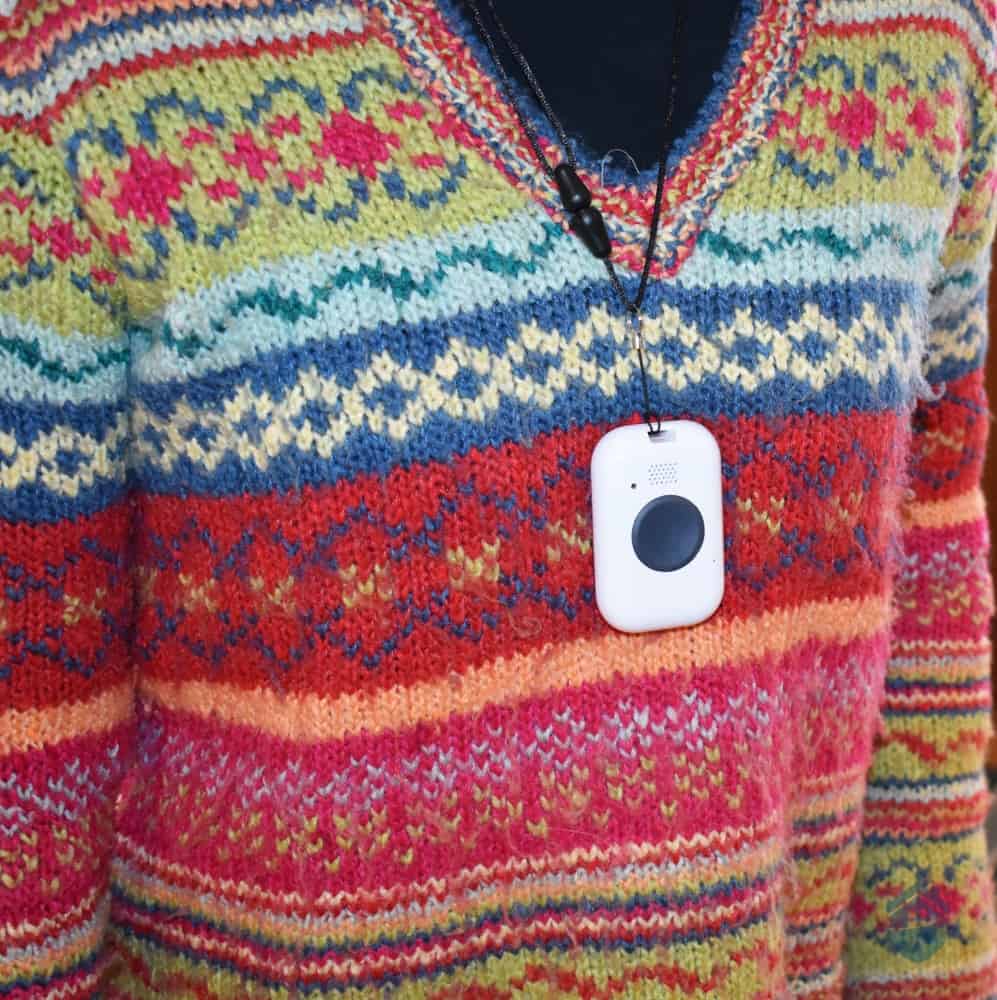
Medical Alert Necklace
Also, it has relatively few elements on its face — a gray emergency button in the center, a speaker on top, an LED battery indicator, and a tiny microphone. Rather than putting extra buttons and lights on the device, the designers enabled the single button and single light to perform various tasks. For example, to power off the device, you simply press and release the Help button three times.
We find that to be a double-edged sword. On one hand, it keeps the interface simple with just one button. On the other hand, users with memory issues might find it difficult to control the device. It may be a good idea to practice with your loved one every once in a while, especially in triggering the Help function. After all, Medical Alert recommends testing it at least every month.
Did You Know? Your Medical Alert mobile device should always remain turned on except when you are on an airplane.
The Medical Alert Mobile LTE includes two-way talk and GPS location detection, two safety features that are industry standards on mobile devices. One thing that is not an industry standard, however, is location detection for caregivers. This feature is available through the Mobile LTE and an accompanying caregiver’s app. (More on this later.)
Finally, the device includes an emergency call cancellation feature. An emergency call can be cancelled by pressing the emergency button for two seconds. We liked this function. Mistakes can be made, and minds can be changed. This is another feature that not all mobile devices offer.
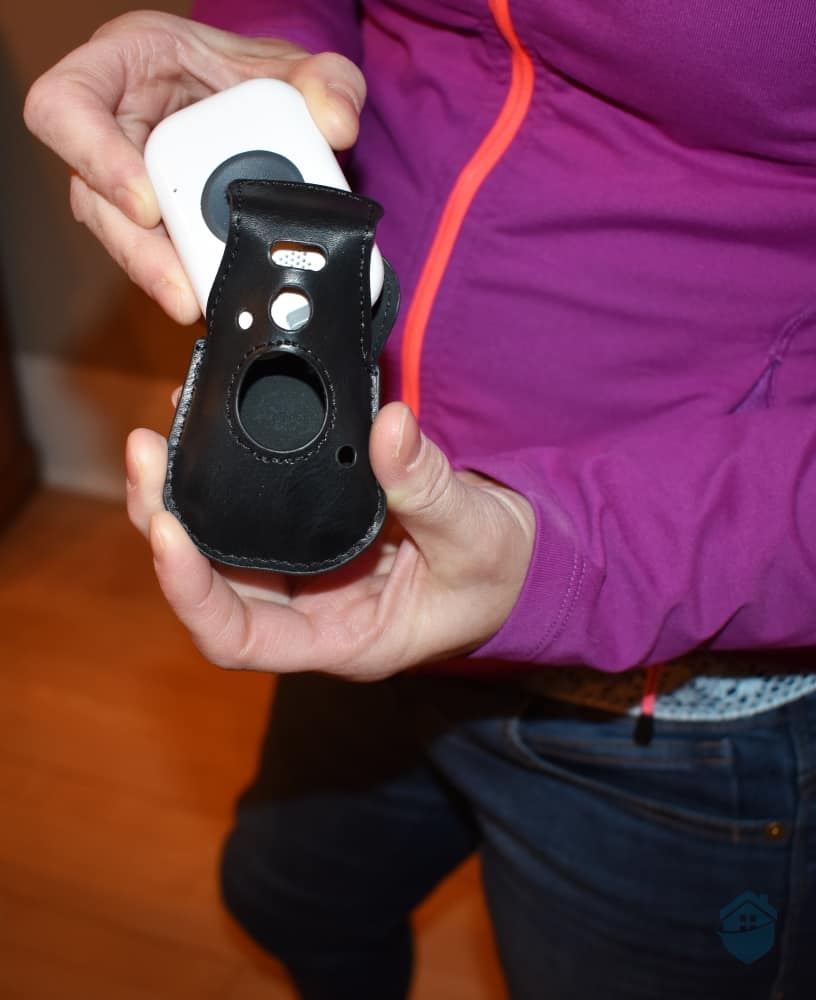
Inserting the Medical Alert Device into the Belt Clip
We tested the emergency button several times over the course of a few days, and each time a monitoring center associate connected in under 20 seconds! That’s impressive. In fact, it is one of the best response times we’ve seen.
Here’s a short video we made that highlights Medical Alert’s response time:
The monitoring center is TMA Five Diamond certified, the gold standard in monitoring services. We found the well-trained associates to be efficient and professional. They also are able to provide real time translation in 140 languages through a translation service.
The customer service representatives were equally professional the few times that we called with questions. One thing that we came to understand about Medical Alert is that their representatives are trained to ask customers pointed questions about mobility or health concerns so that they can direct them to the best product possible. Recognizing that an individual with Parkinson’s disease has very different needs than the person with a heart condition, they are laser focused on finding the best fit for each customer, based on health conditions or ailments.
When we first learned that fall detection could not be added directly to our mobile device, we were a bit disappointed.
We believe that fall detection is an important feature for older adults both for falls that can produce a life-threatening injury or a life-threatening medical emergency that can produce a fall. These events occur more frequently than many people realize with one in three adults over the age of 65 falling every year.2
Well, Medical Alert does not add fall detection to the Mobile LTE for a very good reason, as Leslie later explained to us. This particular mobile device was designed with older adults who wear pacemakers or defibrillators in mind. And because the mobile device contains a magnet on the back, it could interfere with the pacemaker or defibrillator if placed too close to it.3
FYI: Medical Alert recommends wearing the device in its belt case rather than on a lanyard. The fall detection button (which does not contain a magnet) can then be worn around the neck safely (though it should still be at least three inches from the pacemaker or defibrillator), adding an important layer of safety.
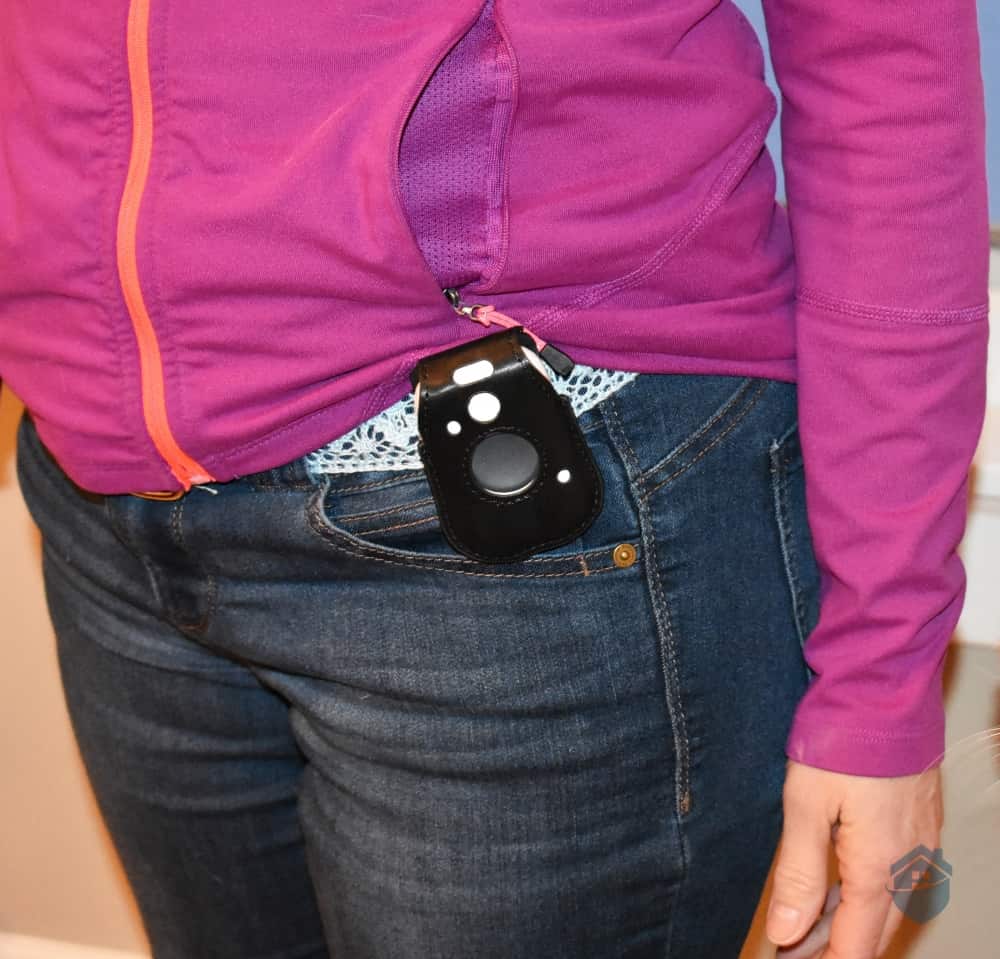
Medical Alert Belt Clip
For those older adults who do not use a device such as a pacemaker, another of Medical Alert’s mobile devices may be a better fit. The On The Go and On The Go LTE come with the option to have the fall detection programmed directly to them, so that another wearable fall detection pendant is not required. We will warn you that these different types of mobile devices are not advertised on Medical Alert’s website. Your best bet to finding a good fit is to speak with one of the competent customer service representatives like Leslie.
We couldn’t find much to dislike about Medical Alert’s On-the-Go system. We loved its simplicity, size and variety of features. And though we started out disappointed that the device couldn’t include fall detection, we came to understand that Medical Alert is serving a specific population of older adults with this specific device while ensuring that other options exist for the more general population or for those who have different health concerns.
We haven’t talked much about the button aside from fall detection. Remember that fall detection is an extra that can be added to the button. Without fall detection, the button serves another purpose — at-home protection.
You may opt to wear the mobile device while inside or swap out the mobile device for the button, either on the lanyard or watch band, when you return home from an outing. Either way, Medical Alert recommends that the mobile device be charged daily, at which time the button should be worn for full protection. Here’s a peek of the watch band in action…
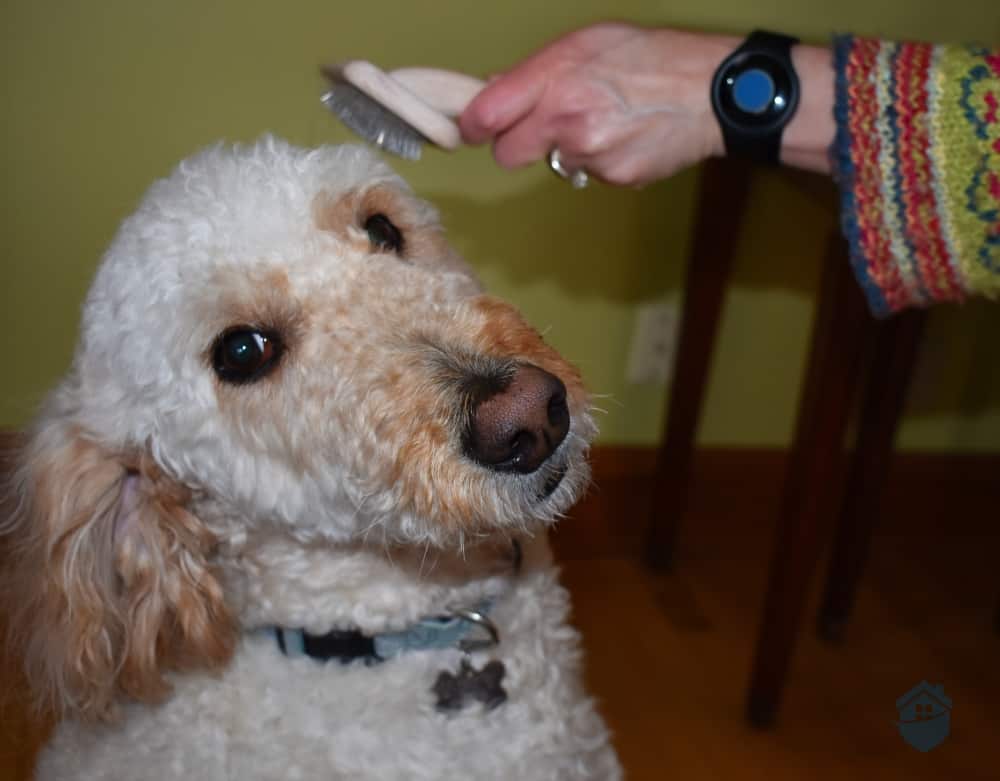
Wearing the Medical Alert Wrist Pendant
While the button does not include two-way talk, it does communicate an emergency to the response center so that you or your loved one can get the help you need.
Note that the button does need to be within 400 feet of the mobile device in order to successfully send a call to the response center. Now, if you are as spatially challenged as we can be, it may be helpful to know that this is about as long as a football field. (In case you are interested, it is also 9/10 as tall as the Great Pyramid of Giza.)
We found that the button is waterproof, making it the perfect company to the bath or shower or while washing the dishes. In contrast, the mobile device is splashproof, but not completely waterproof.
The button is also small enough that you can even sleep wearing it. If you have to get up in the middle of the night, for instance, you will always have emergency protection. We recommend using the wristband when going to bed with the button, though, as the lanyard can be a strangulation hazard.
In 2020, 53 million people identified as caregivers in the United States. That’s one in five Americans.4 So in our book, any assistance for caregivers that can be embedded in medical alert systems is worthwhile. Medical Alert offers an app for smart devices that provides several valuable features.
We touched on one of these features above — caregiver location detection. If a loved one’s extra lengthy grocery shopping trip is causing worry, you can check their location to ensure safety. This simple tool can provide peace of mind. It can also be life saving for an older adult who is unable to press the help button but has become lost, disoriented, or had some kind of medical emergency while away from home.
The app also enables a caregiver to quickly and efficiently call for emergency help from the monitoring center through the app. Any seconds or minutes saved during an emergency can be vital.
Fast Fact: The medical alert industry average for response time is 30 seconds. Response time refers to the amount of time between the moment that an older adult presses the emergency button and the moment that a response center associate connects.
Also worth mentioning are the caregiver notifications. These alerts are sent through the app if a loved one has pressed the emergency button. They also indicate if the monitoring center request is an actual emergency or a test.
We think that the capabilities that this app offers are a big bonus.
Aging in place, especially if a loved one has a health condition requiring a pacemaker or defibrillator, is much more realistic if strong communication and monitoring channels are in place. The Medical Alert Connect mobile app is a great way to help ensure exceptional monitoring.
While we were excited with some of Medical Alert’s features and capabilities, we paused when we learned of its $42.95 monthly cost. However, after we dug deeper into the pricing, we realized that the monthly cost covers fees that many other providers tack on as an extra charge. This includes equipment fees and add-on fees for important caregiver services like GPS location detection for caregivers and alerts for help button presses.
As a point of comparison, Bay Alarm Medical sells a mobile device, the SOS Mobile, for only $29.95 per month, but they also charge $79 for the equipment. MobileHelp, another provider known for low monthly fees, charges $33.95 and $37.95 per month for their on-the-go systems. However, they also charge $5 per month for Connect Premium, their version of a caregiver app.
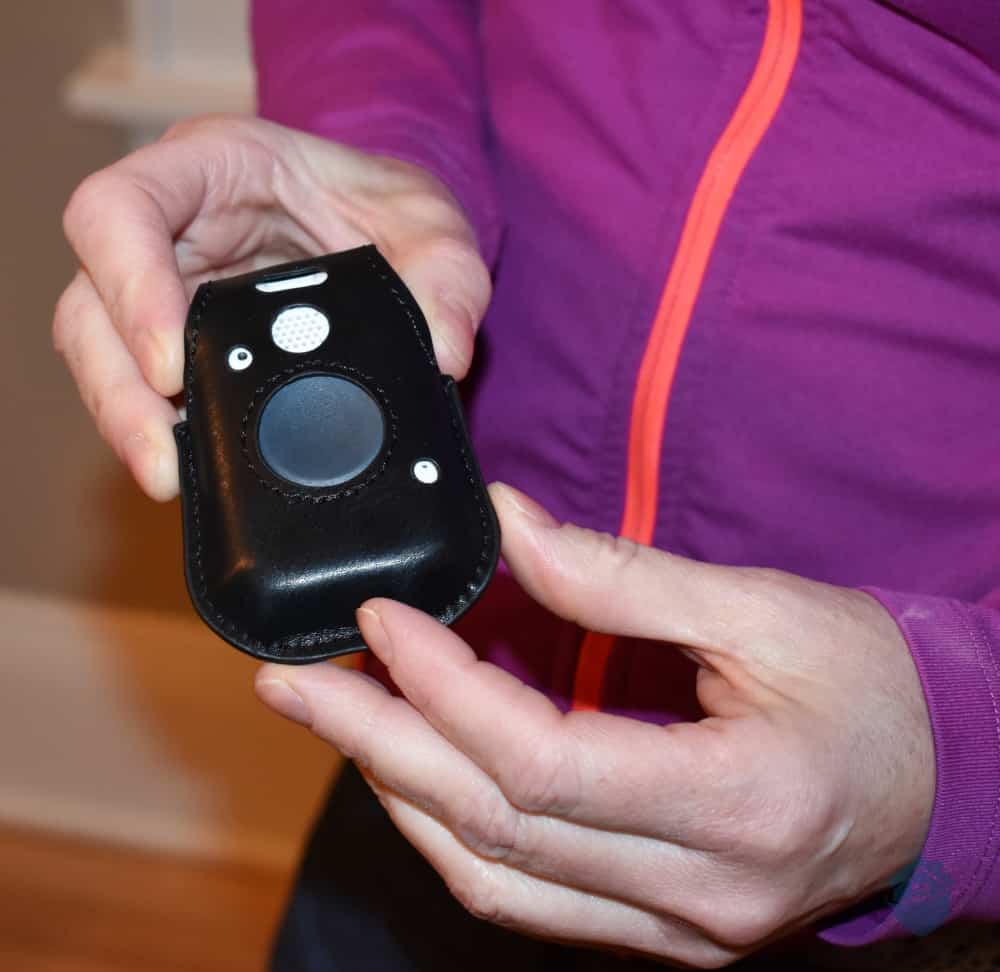
Closeup of the Medical Alert Belt Clip
What about hidden fees? Good question! Nothing irritates us more (except maybe robocalls and below-the-speed-limit drivers in the left lane) than hidden fees such as activation or installation charges. With some systems, these extra costs can really add up, leaving you with a price tag you weren’t expecting. We are happy to report that Medical Alert does not include such charges, leaving us irritation free!
For a closer look at Medical Alert’s pricing, see our chart below.
| Type of System | Basic Monthly Fee |
|---|---|
| Home Landline | $22.95 |
| Home Cellular | $32.95 |
| Mobile | $42.95 |
Also worth mentioning is Medical Alert’s optional semi-annual and annual payment plans. Free shipping is included if using either of these payment plans. In addition, a free lockbox and one month of free service is included if opting for the annual payment plan.
Overall, we think Medical Alert offers competitive pricing. However, if finding a low monthly fee is your number one priority, you may want to look into Bay Alarm Medical. In our research and testing, we’ve found that Bay Alarm Medical alert systems balance quality products with affordable prices.
Most medical alert systems offer add-ons in order to customize your system. Medical Alert is no exception although they do keep the extras to a minimum.
Emergency room doctors may be best positioned to recognize the value of fall detection in a medical alert system. This is because every 11 seconds an older adult in the U.S. is treated in an emergency room for a fall. We have found that most systems do offer some form of fall detection in their devices and often this newish technology comes with an additional $5 to $10 fee.
In line with other brands in the industry, Medical Alert charges an additional $10 for fall detection.
The second add-on that Medical Alert offers is a protection plan which costs $5 per month. This protection provides up to $350 in coverage if your system is lost, stolen or damaged.
And if you are not opting for an annual payment plan, you may be interested in purchasing a lockbox, which costs an additional $2.99 per month.
FYI: Medical Alert runs special deals from time to time. Be sure to check their website or ask customer service about current offers. For example, during a recent review, we found a limited time offer on the protection plan for $1 per month.
That’s it on the add-ons. Again, Medical Alert likes to keep it simple. And we can appreciate that.
If you like to have lots of options in order to dress things up, we recommend you read our review of Medical Guardian. This medical alert system begins with a single base device and builds up the system with no less than eight add ons to choose from.
We applaud Medical Alert for not lumping older adults all in one category. Because individuals have different health needs and preferences, a one-size fits all model doesn’t always work. In the case of the Mobile LTE, the many older adults out there with pacemakers or defibrillators have a device designed specifically for them.
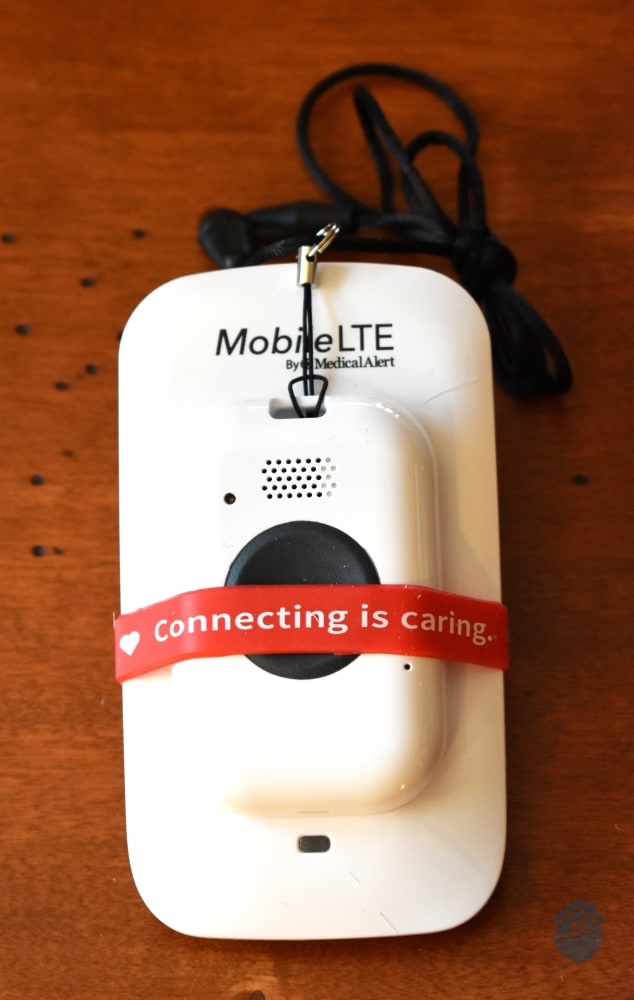
Medical Alert On-The-Go Device
At the same time, we feel pretty confident that other Medical Alert models will offer the same quality for other populations of older adults.
At the top of our list of Medical Alert benefits is response time. With a 19-second average, you really can’t beat it. But if you really wanted to try, we suggest reading our Lively review. Lively’s focus is solely on mobile devices and boasts a very quick response time.
We also liked the no-frills approach to their design. The mobile device is small, light and simple, yet still provides essential safety features. And the add-ons are kept to a minimum.
If we had to critique one thing, it would be Medical Alert’s website. Some of the details were unclear. And nowhere did it explain that the Mobile LTE is designed for a targeted group of older adults. Finally, we would have liked to have seen information on the other mobile devices that Medical Alert offers in an easy-to-find place.
However, the most important pieces to the Medical Alert system are securely in place. The product itself is affordable, easy to set up and use and the best of the best in response time.
The mobile alert system will work anywhere in the United States, provided it has AT&T coverage.
The mobile device is water resistant; it can be used in the shower. However, the help buttons are waterproof, so they can be submerged in a tub.
Medical Alert offers a 30-day, money-back guarantee on all of its medical alert systems.
Not a problem. The response center staff is trained to use a real-time translation service that is capable of translating 140 languages.
If you press the help button and a monitoring center associate is unable to speak with you, they will still dispatch emergency services. A message will also be relayed through the caregiver’s app.
Connectamerica.com. (2021). A Connected Health Leader focused on Remote Monitoring.
https://www.connectamerica.com/about-us/
National Institute on Aging. (2017, March 15). Prevent Falls and Fractures.
https://www.nia.nih.gov/health/prevent-falls-and-fractures
American Heart Association. (2021). Devices that May Interfere with ICDs and Pacemakers.
https://www.heart.org/en/health-topics/arrhythmia/prevention–treatment-of-arrhythmia/devices-that-may-interfere-with-icds-and-pacemakers
Research report from the National Alliance for Caregiving. (2020, May). Caregiving in the U.S. 2020.
https://www.caregiving.org/caregiving-in-the-us-2020/